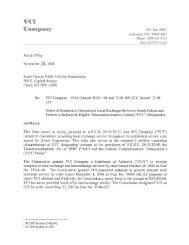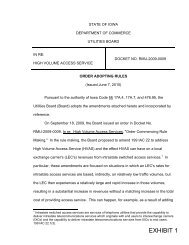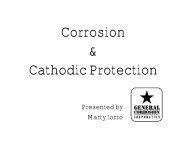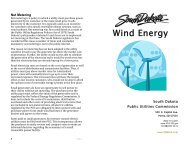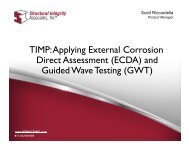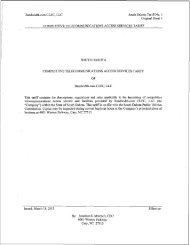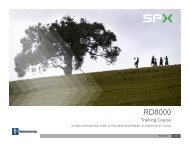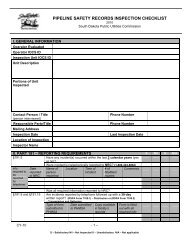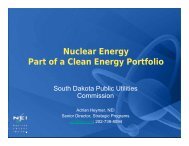Pipeline Safety Inspection Form
Pipeline Safety Inspection Form
Pipeline Safety Inspection Form
Create successful ePaper yourself
Turn your PDF publications into a flip-book with our unique Google optimized e-Paper software.
PROTECTING CAST IRON PIPELINES S N/I U N/A<br />
§192.755 When the operator has knowledge that a segment of buried castiron<br />
pipe is disturbed, does the operator provide protection from:<br />
§192.755(a)(1) Vibrations from heavy construction equipment, trains,<br />
trucks, buses, or blasting.<br />
§192.755(a)(2) Impact forces by vehicles<br />
§192.755(a)(3) Earth movement<br />
§192.755(a)(4) Apparent future excavations near the pipeline<br />
§192.755(a)(5) Other foreseeable outside forces which might subject that<br />
segment of pipeline to a bending stress?<br />
§192.755(a)(6) As soon as feasible does the operator provide permanent<br />
protection for the disturbed section? (See records check list)<br />
CUSTOMER NOTIFICATION S N/I U N/A<br />
§192.16 Has the operator notified all customers by August 14, 1996 or new<br />
customers within 90 days of their responsibility for those sections of<br />
service lines not maintained by the operator? (See records check list)<br />
§192.16 (b) Does the operator have a current copy of the notification?<br />
Does notification contain all the following requirements:<br />
(1) operator does not maintain the customer’s buried piping<br />
(2) if customer’s buried piping is not maintained, it may be subject<br />
to corrosion and leakage<br />
(3) buried gas piping should be:<br />
(i) periodically inspected for leaks<br />
(ii) periodically inspected for corrosion (if metal pipe)<br />
(iii) repaired if any unsafe condition is discovered<br />
(4) when excavating near buried gas piping, the piping should be<br />
located in advance, and the excavation done by hand<br />
(5) the operator, plumbing contractors, and heating contractors can<br />
assist in locating, inspecting, and repairing the customer’s buried<br />
piping<br />
LINE MARKERS S N/I U N/A<br />
§192.605(b) Procedures for §192.707?<br />
§192.707(a) Are buried mains and transmission lines marked as required in the<br />
following areas:<br />
(1) at each crossing of a public road and railroad<br />
(2) wherever necessary to identify the location of the line to reduce<br />
possibility of damage or interference<br />
§192.707(b) EXCEPTIONS where line markers are NOT required:<br />
(1) lines located at crossings of or under waterways and other<br />
water bodies<br />
(2) mains in Class 3 or 4 location where damage prevention<br />
program is in effect under §192.614<br />
(3) transmission lines in Class 3 or 4 locations until 3/20/1996<br />
(4) transmission lines in Class 3 or 4 locations where placement of<br />
line marker is impractical<br />
§192.707(c) Are line markers installed on aboveground areas accessible to the<br />
public?<br />
§192.707(d) Do the line markers have the latest characteristics?<br />
(1) “Warning”, “Caution”, “Danger” followed by “Gas <strong>Pipeline</strong>” (1”<br />
high with ¼” stroke except in heavily developed areas)<br />
(2) name and telephone number of operator (24 hr access)<br />
S – Satisfactory N/I – Not Inspected U – Unsatisfactory N/A – Not applicable<br />
- 8 -



